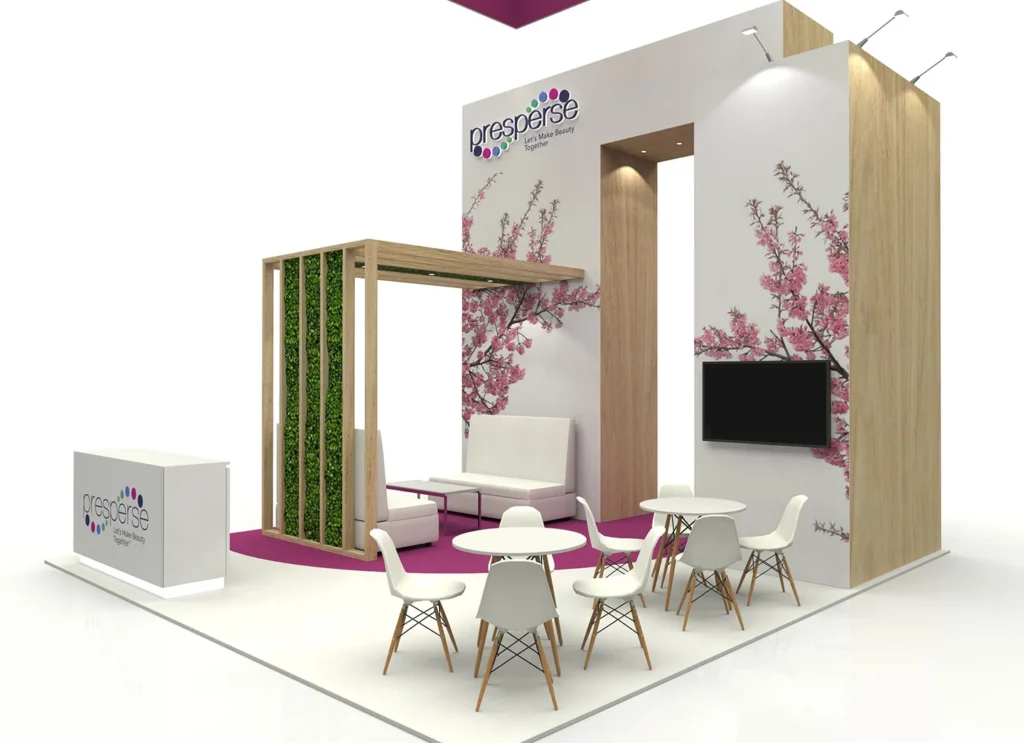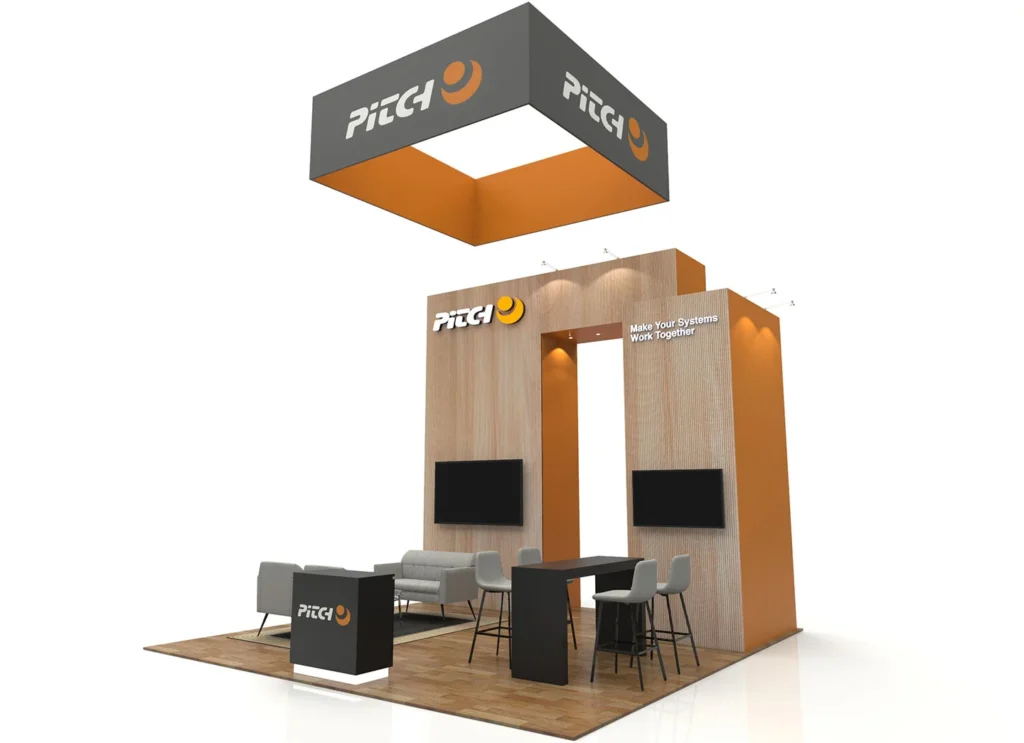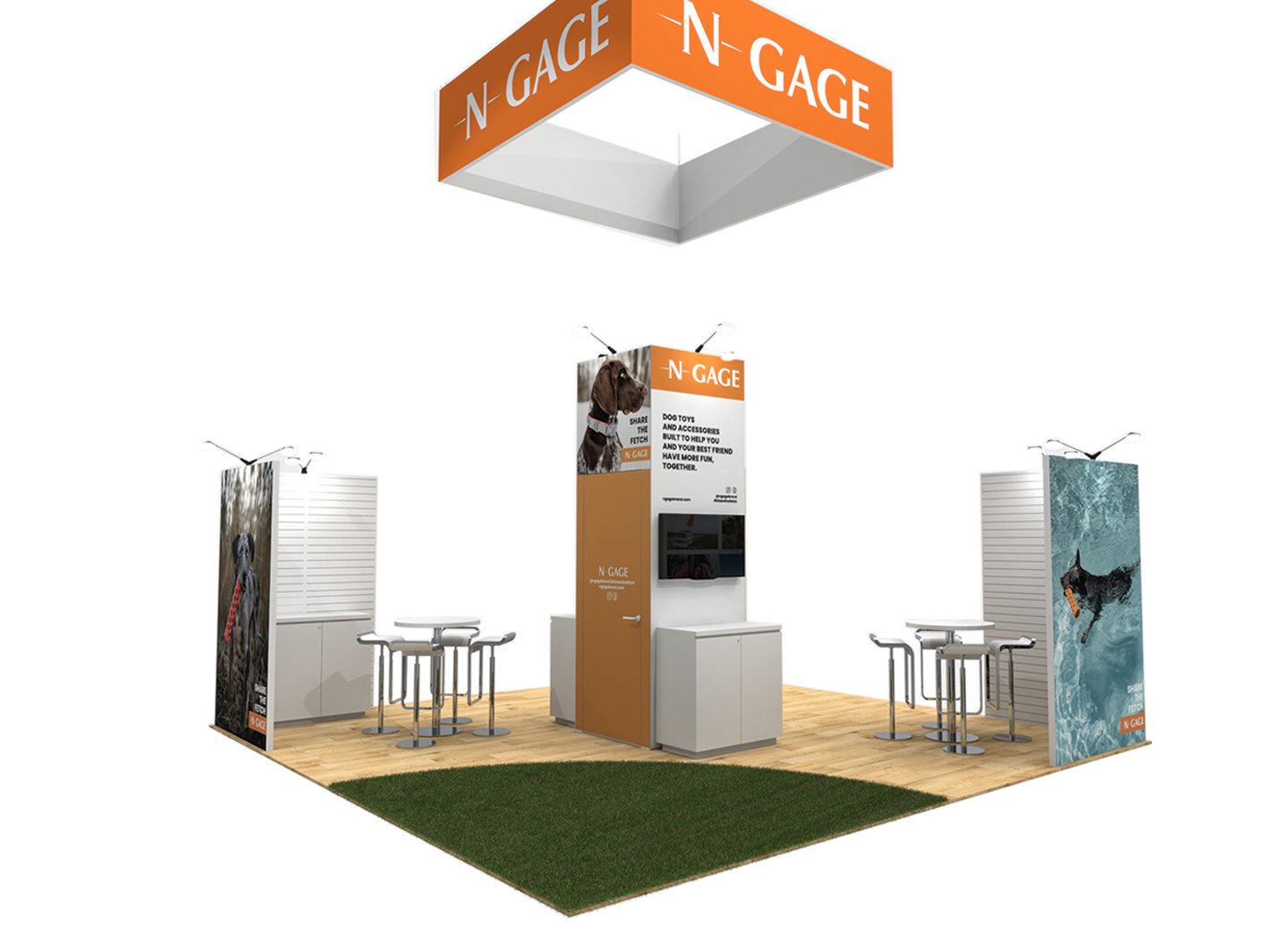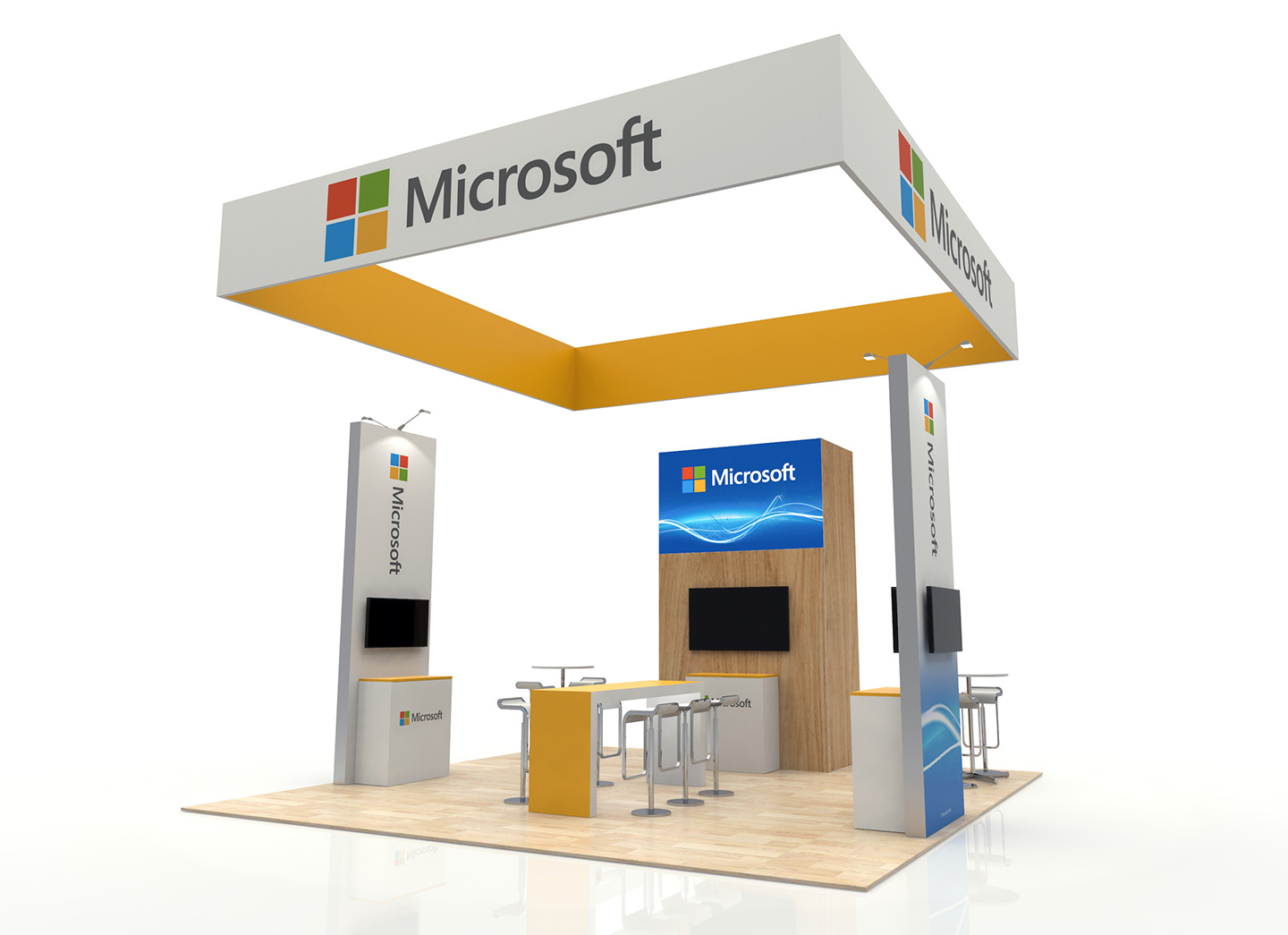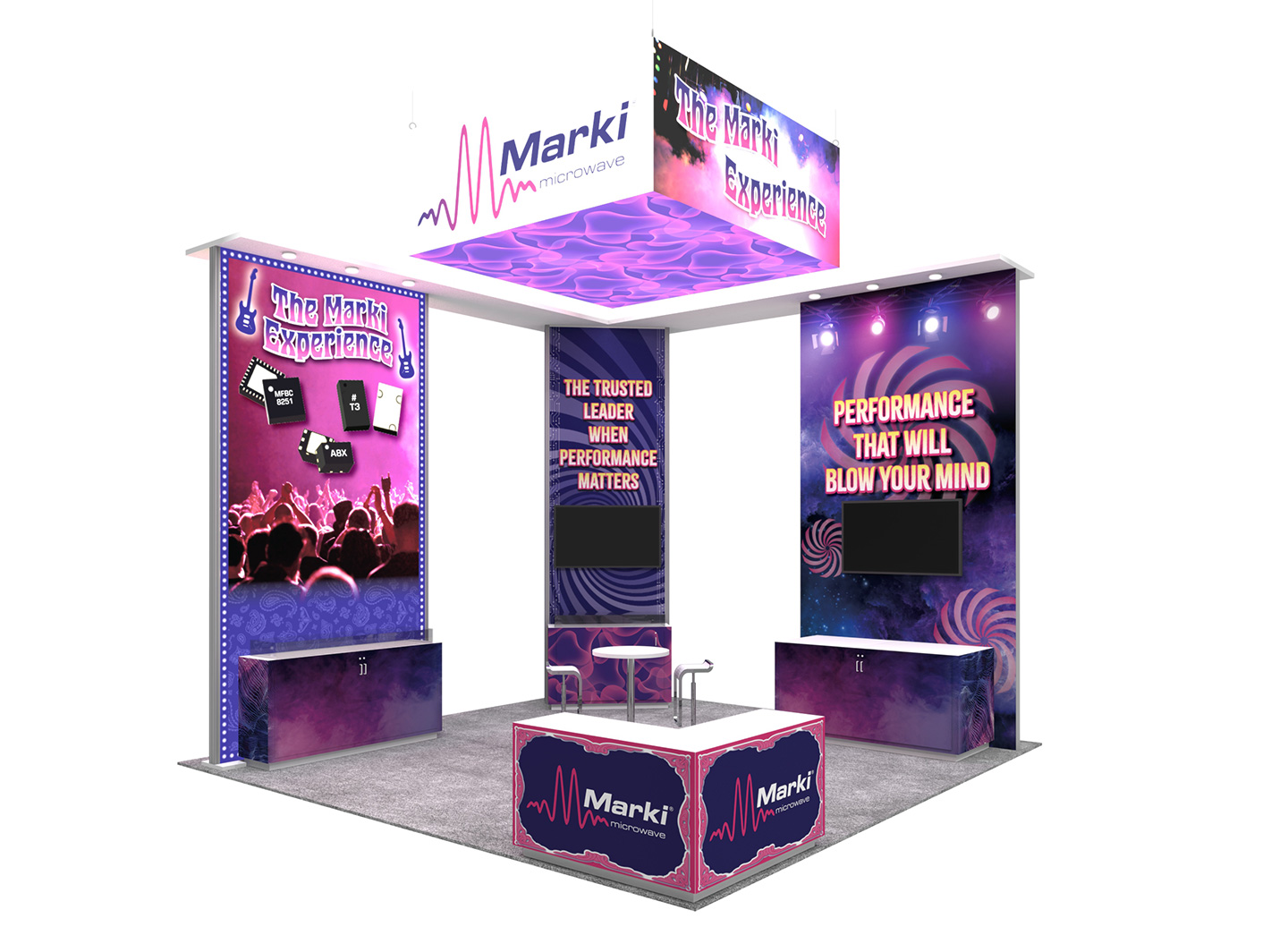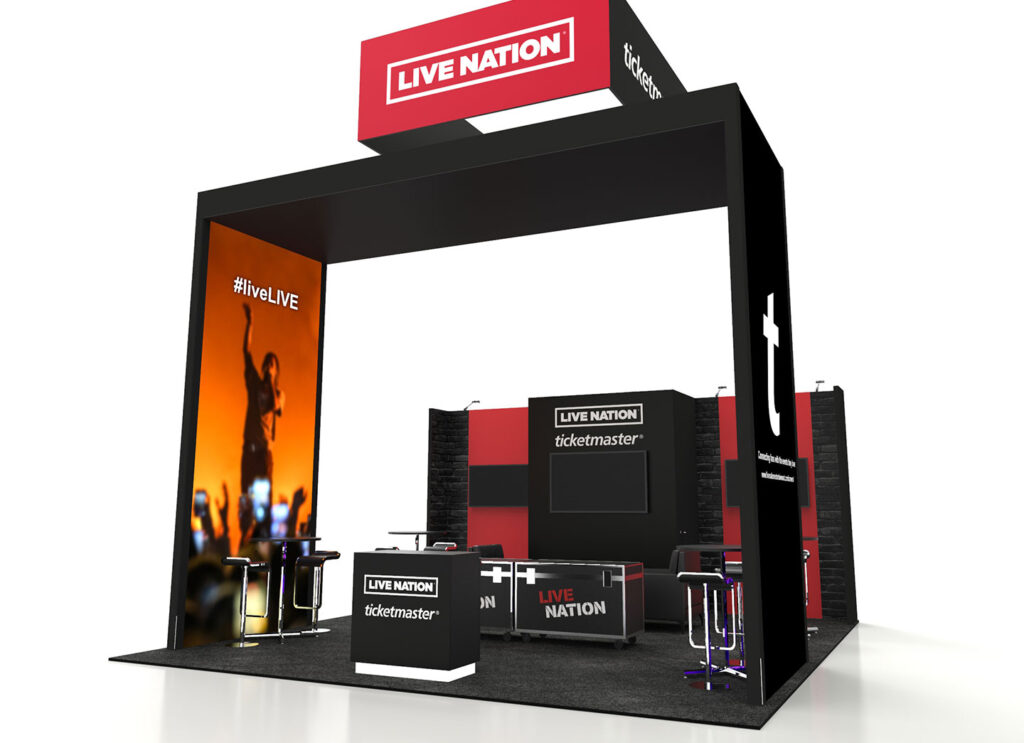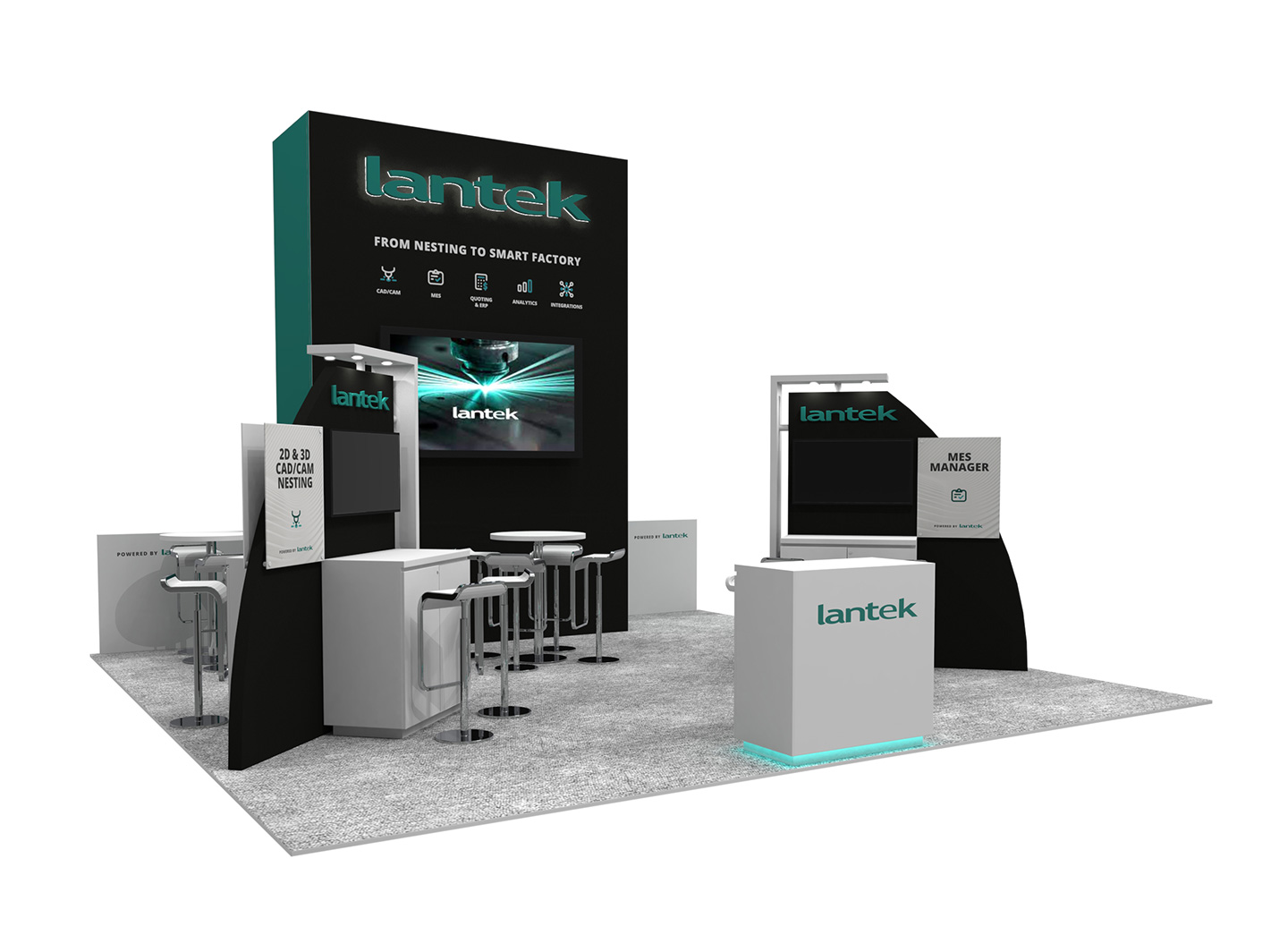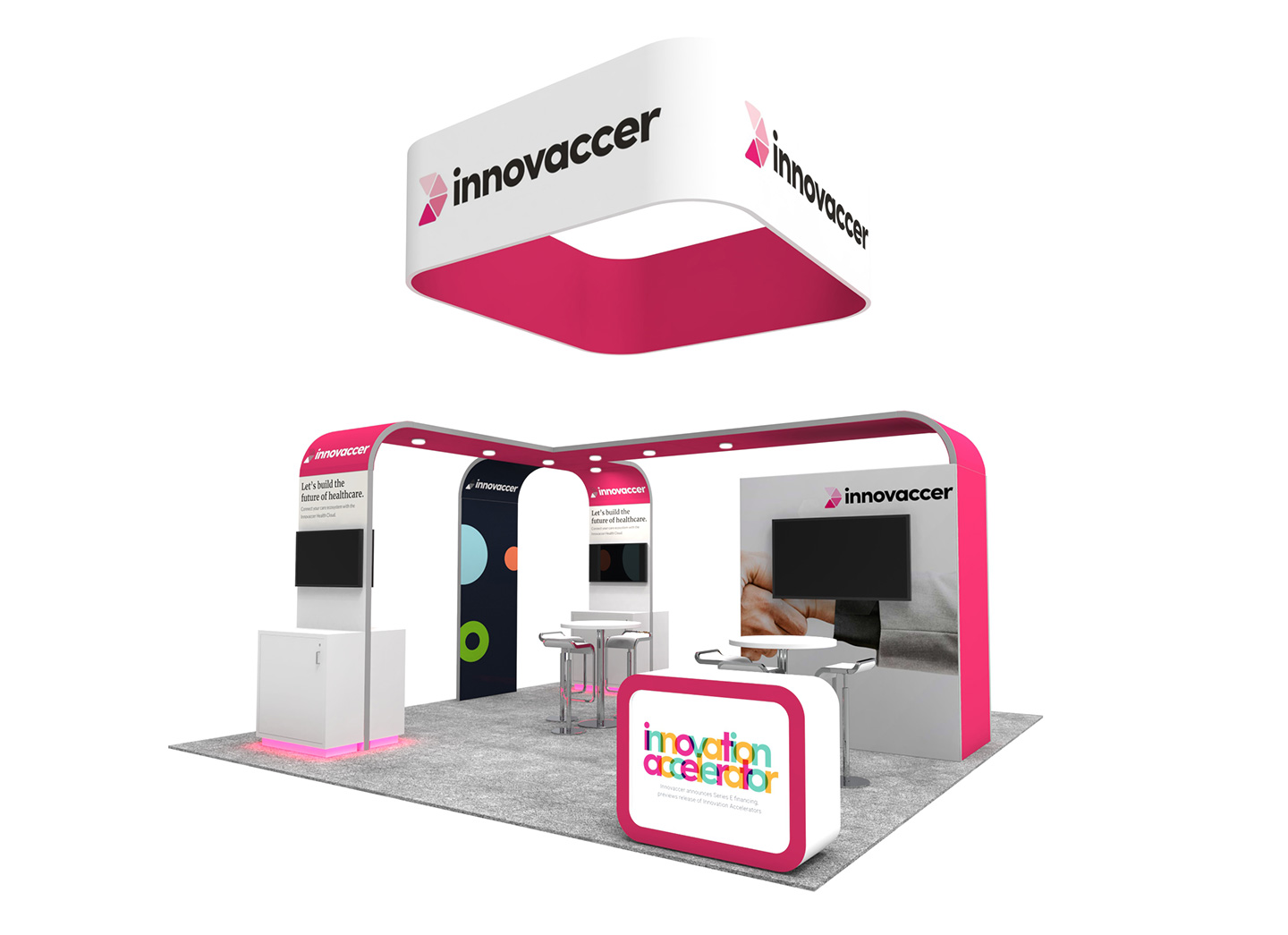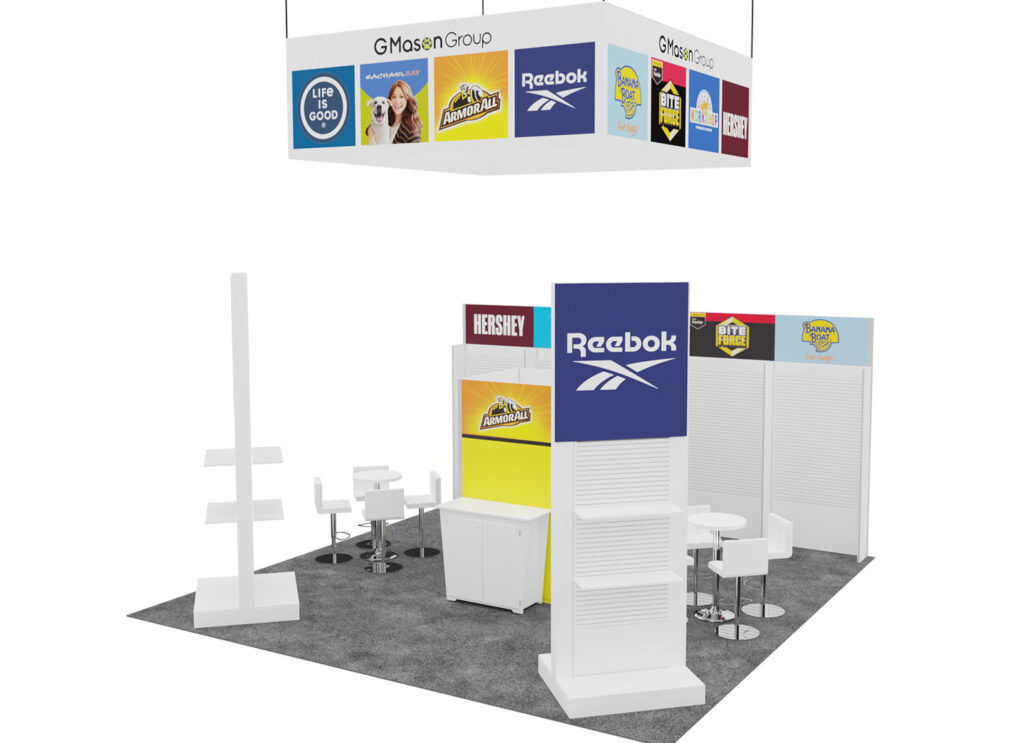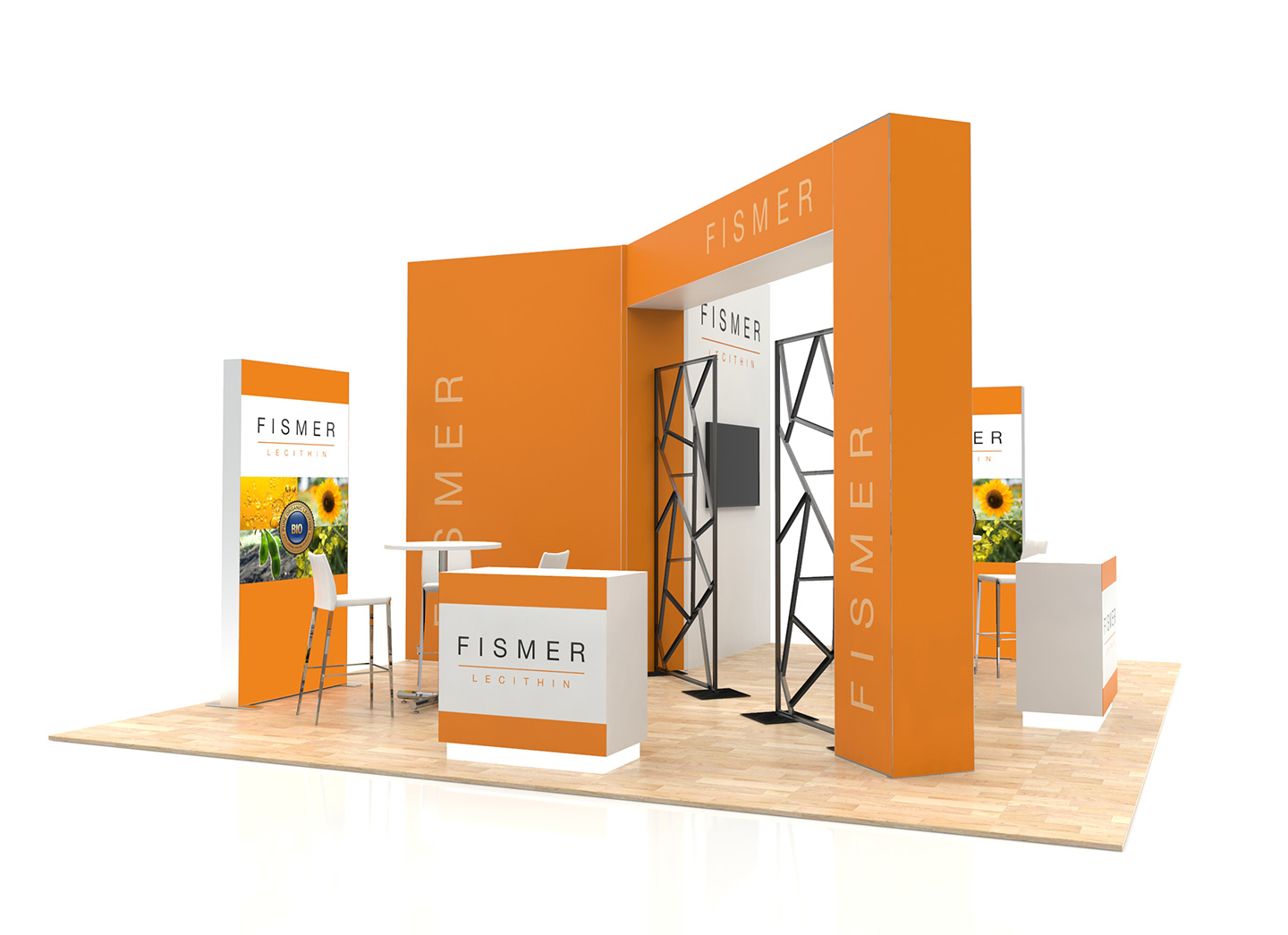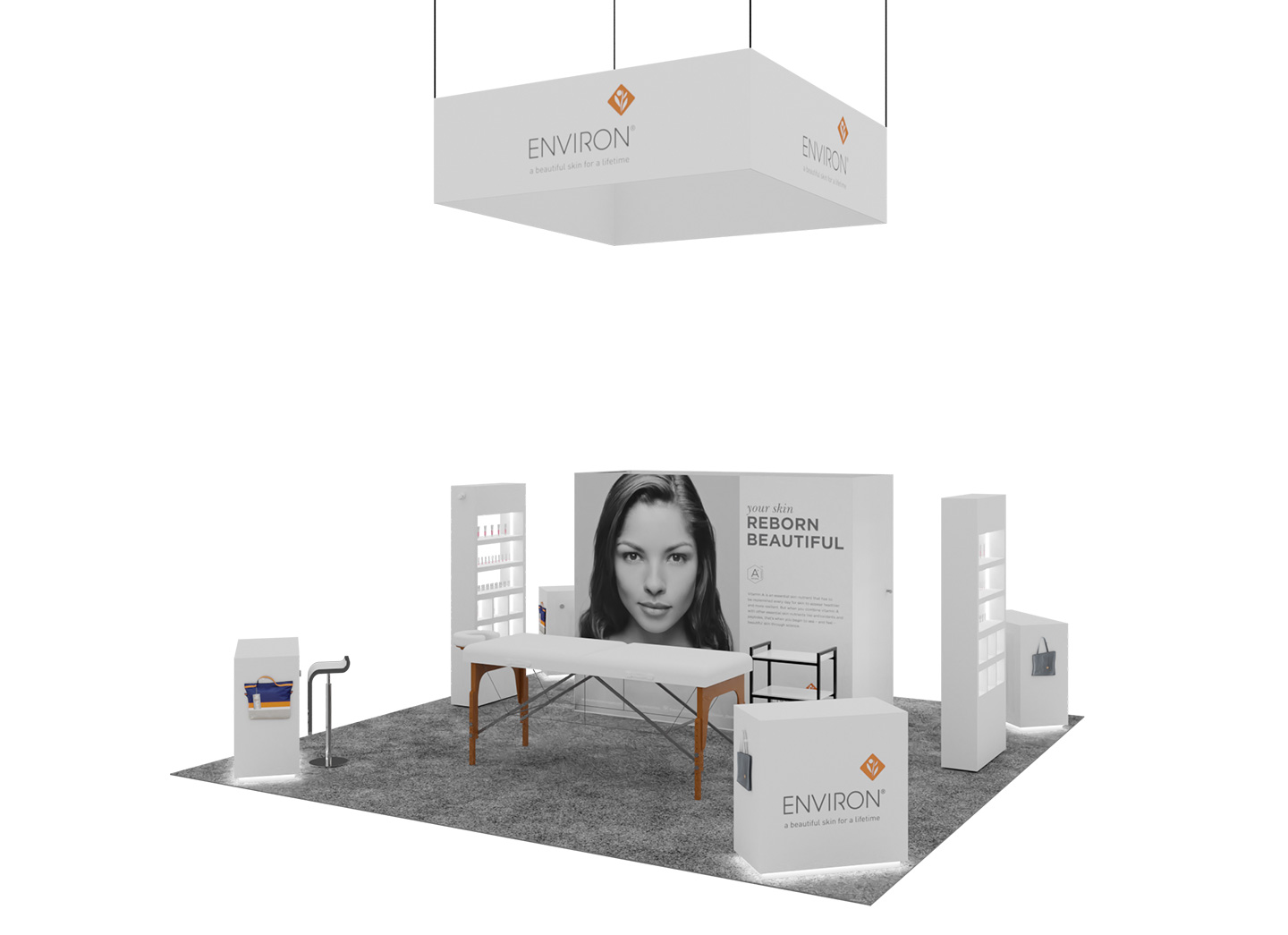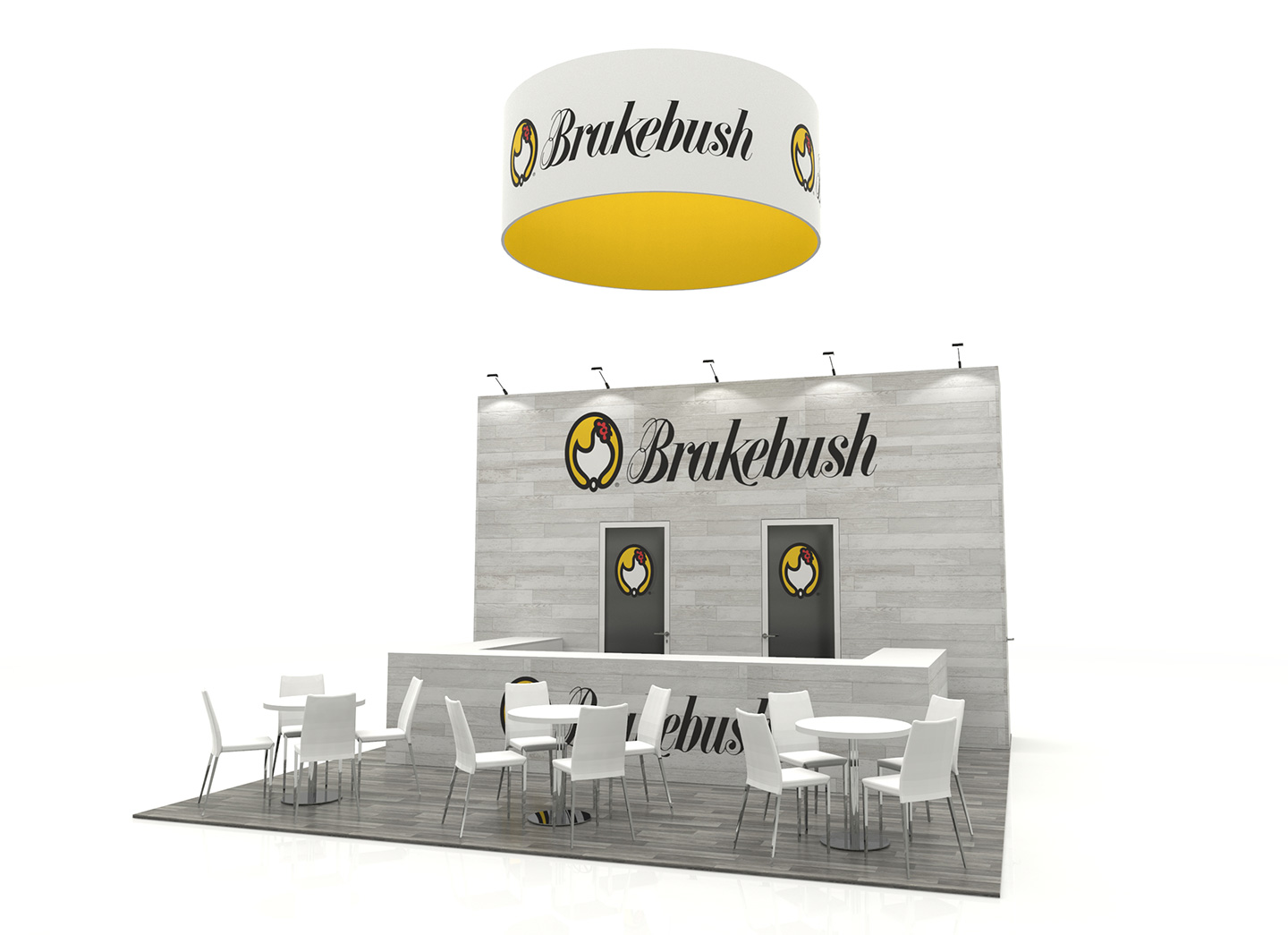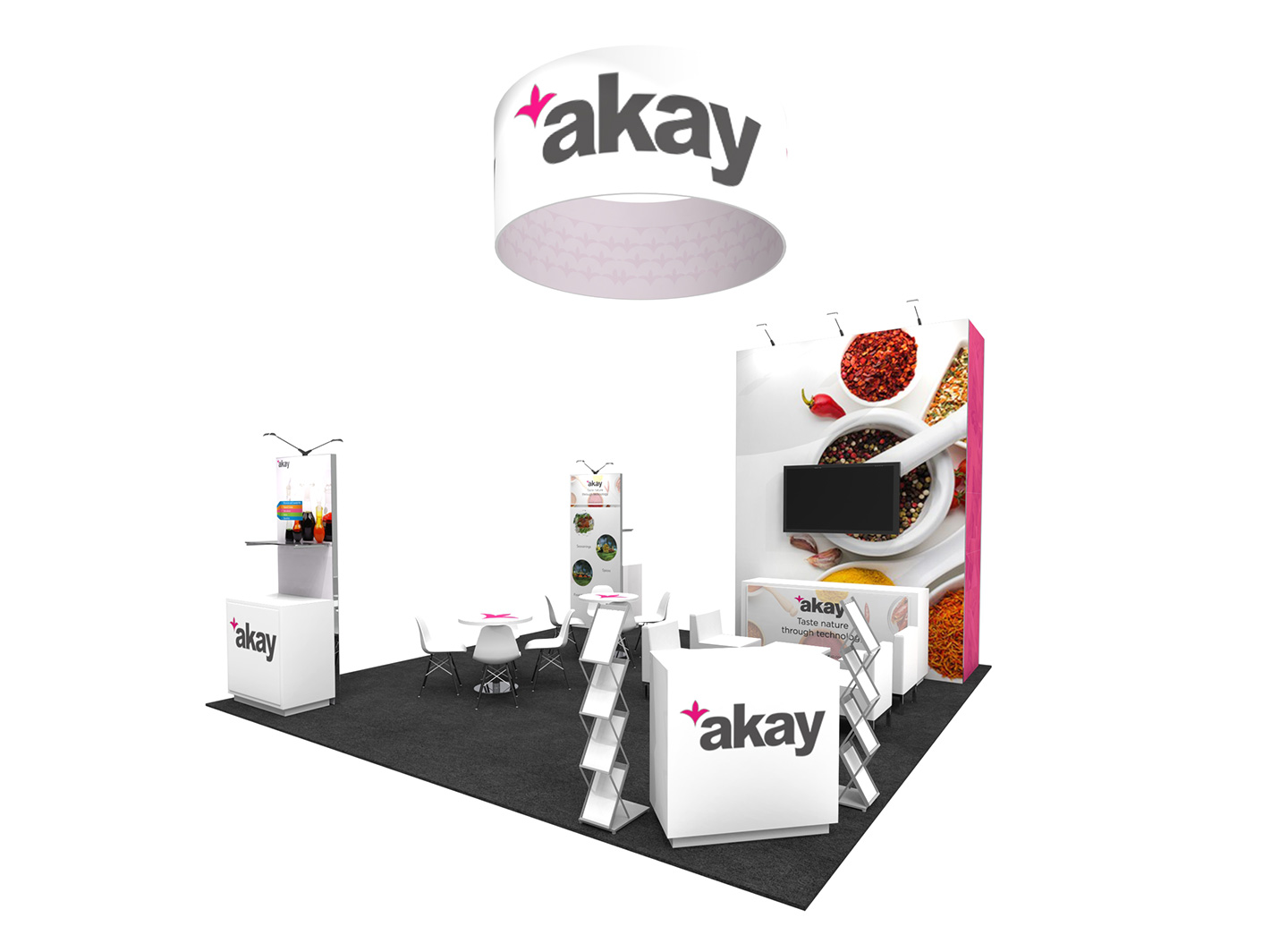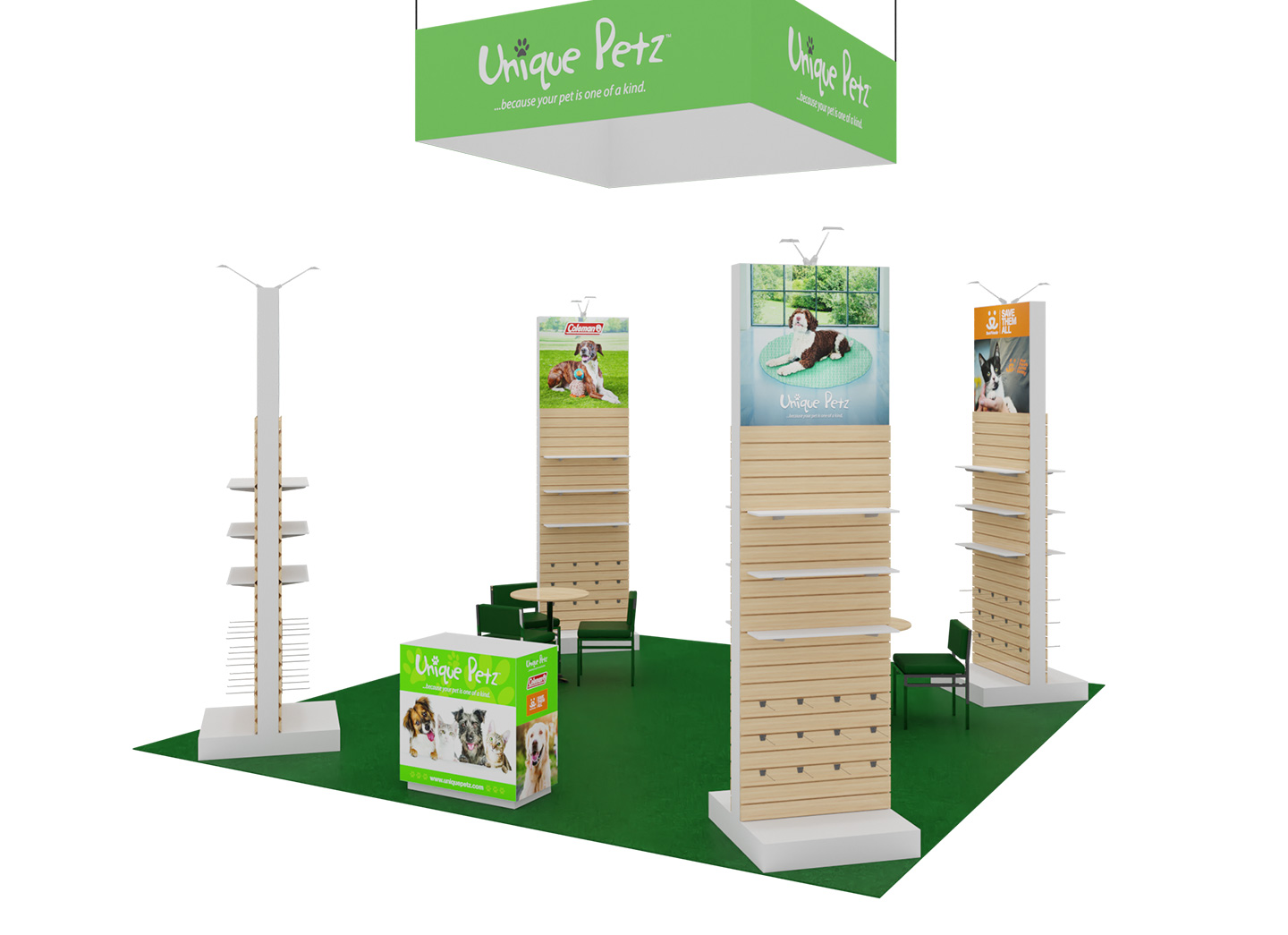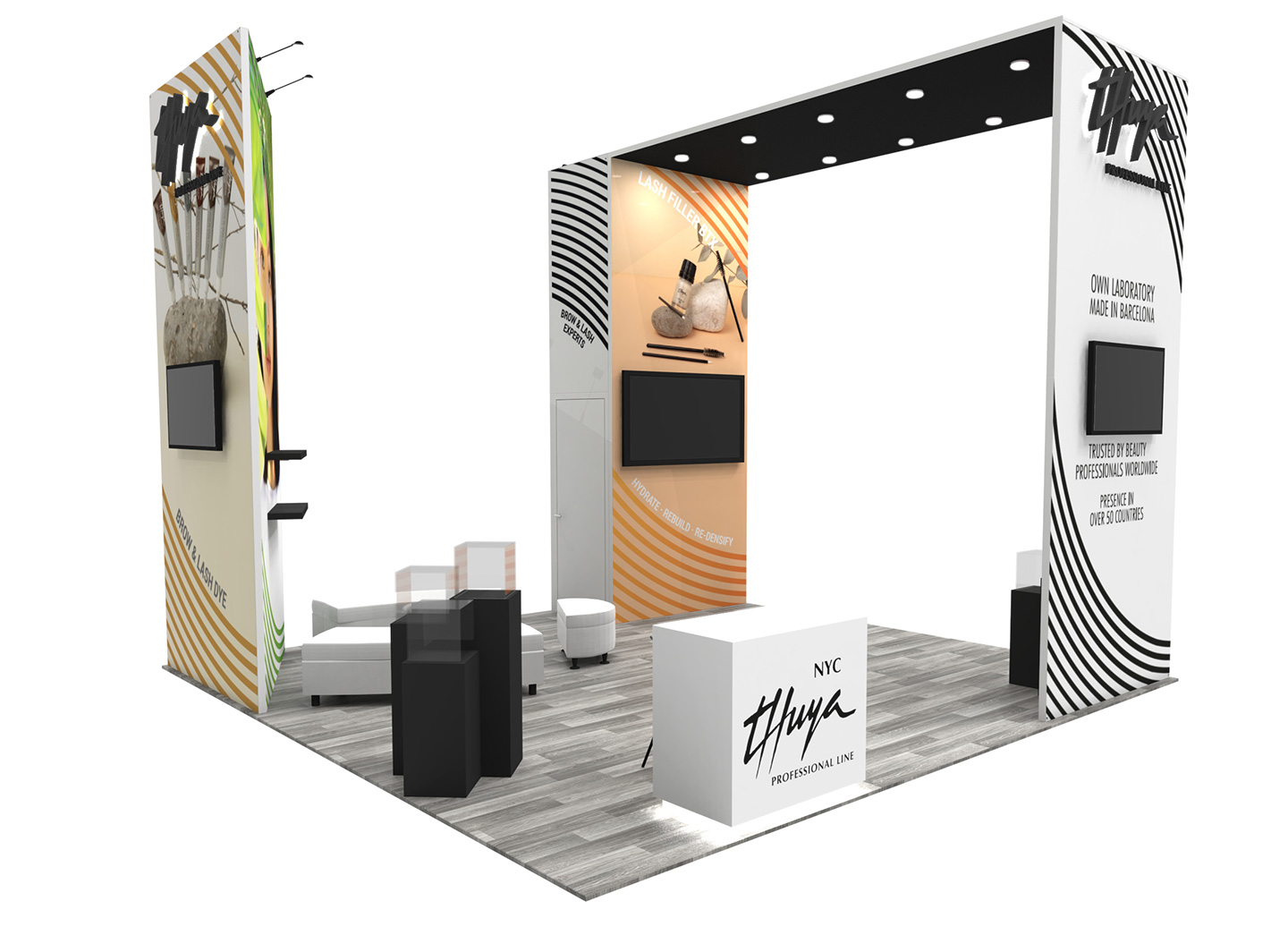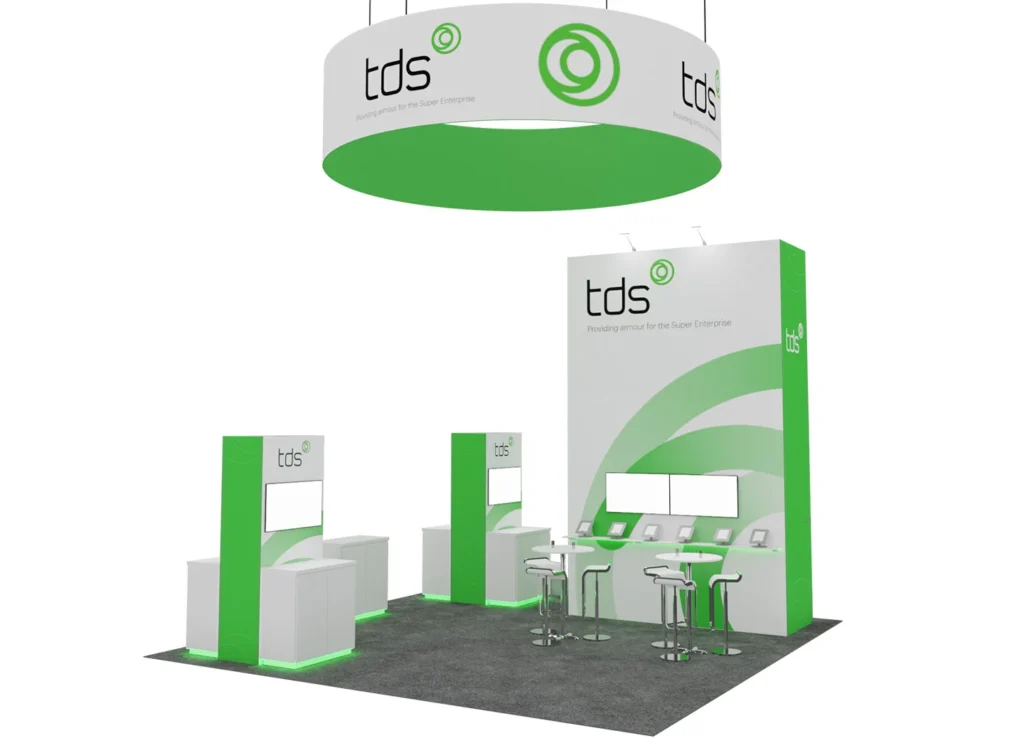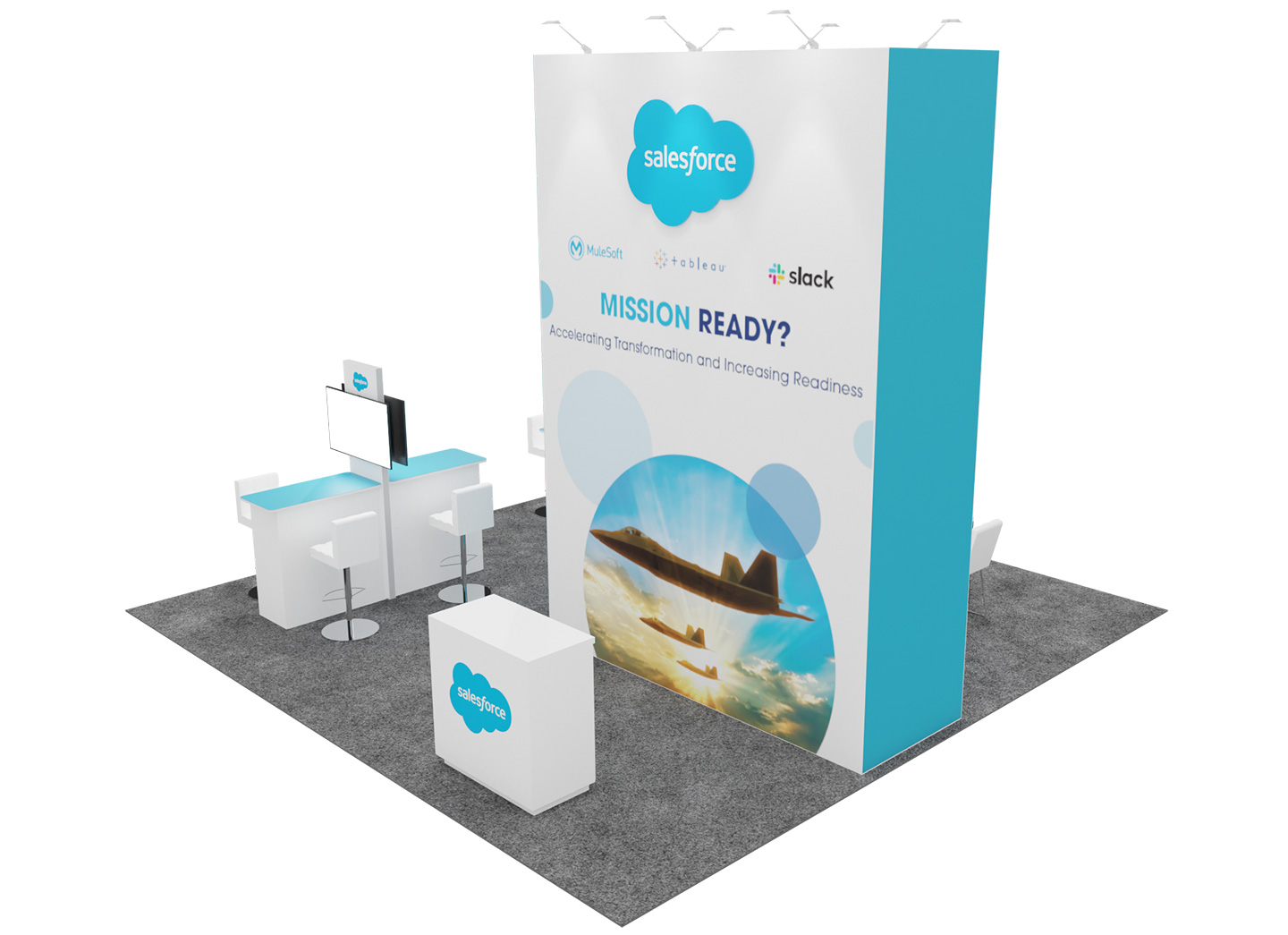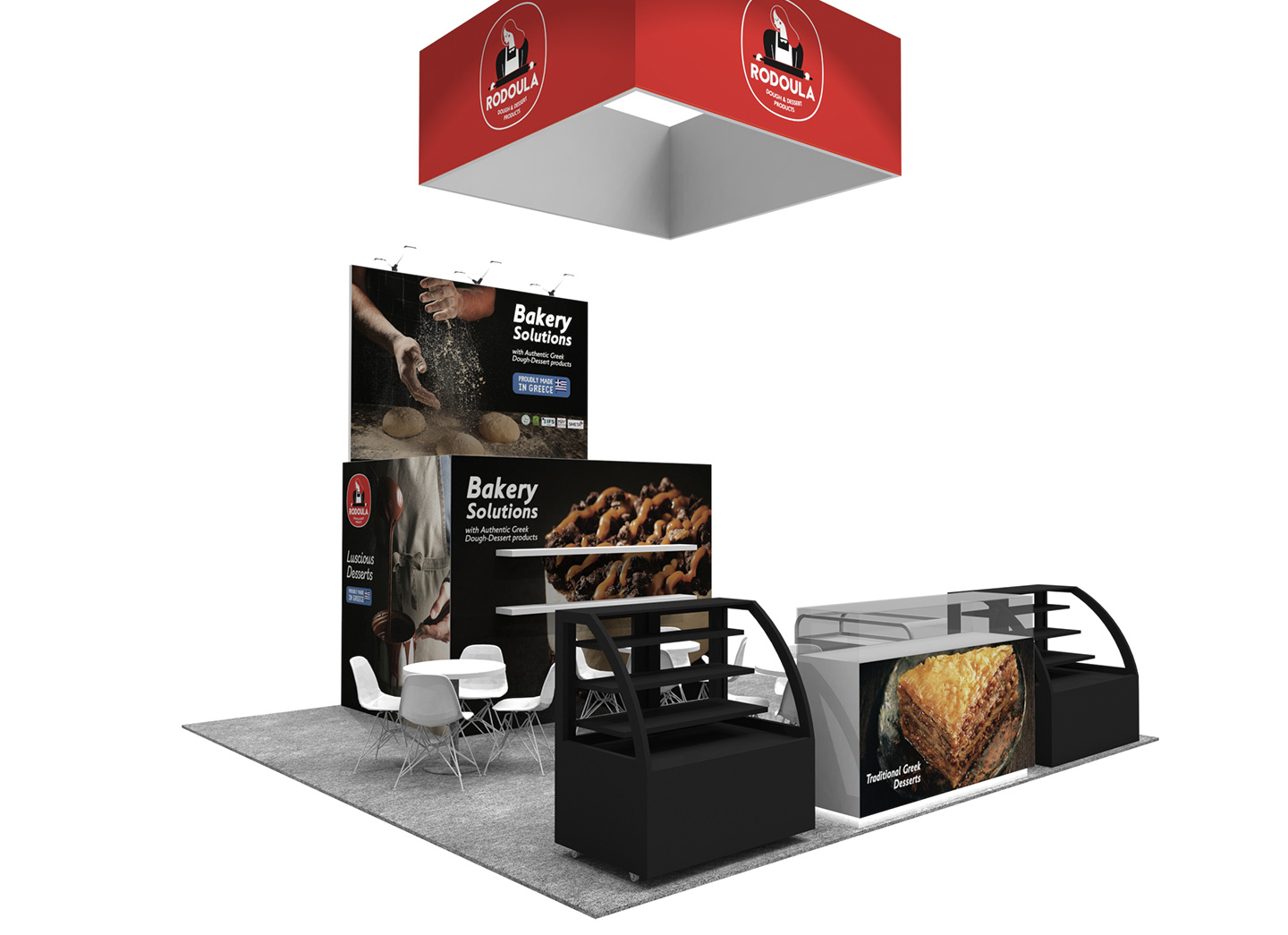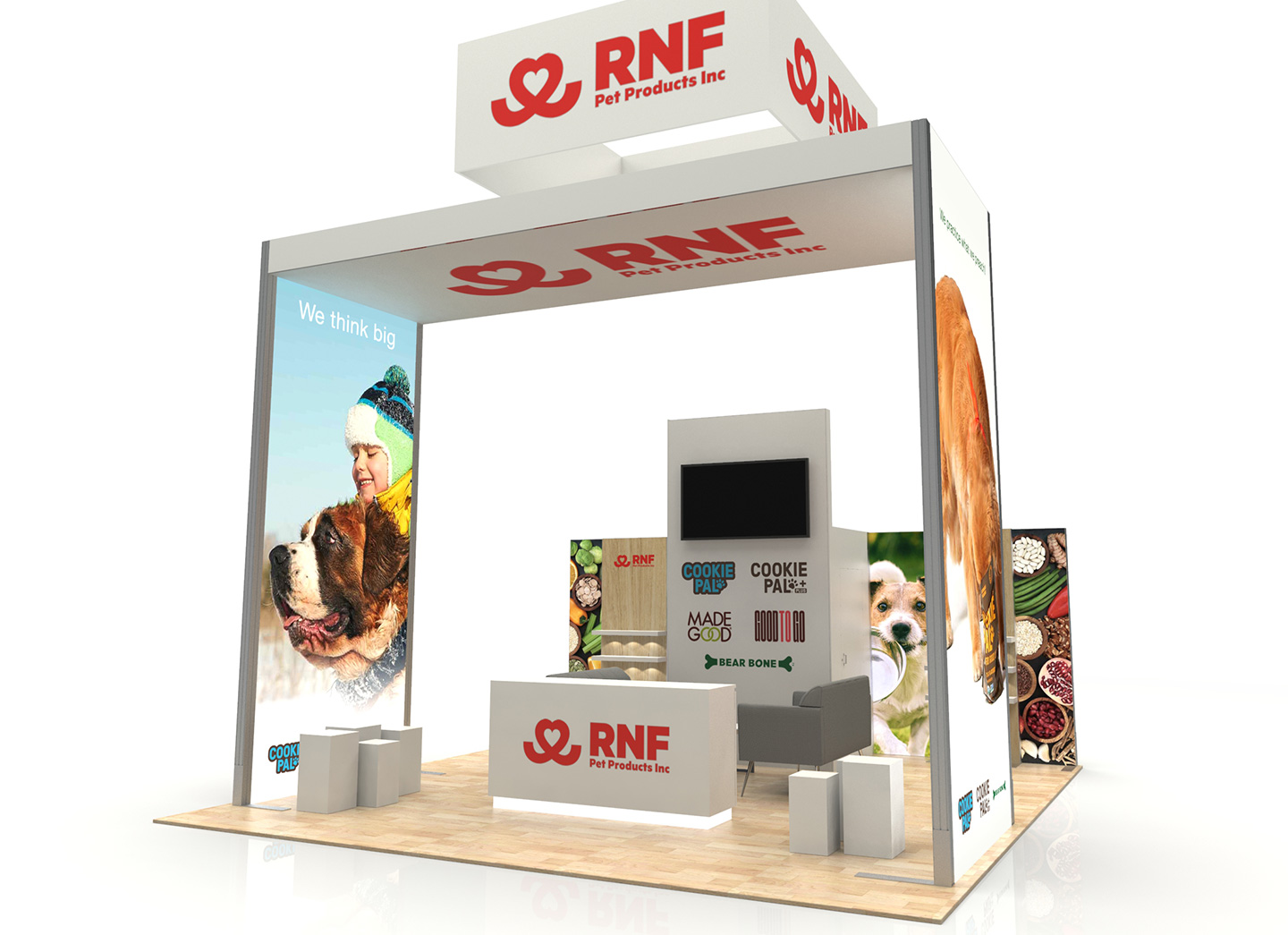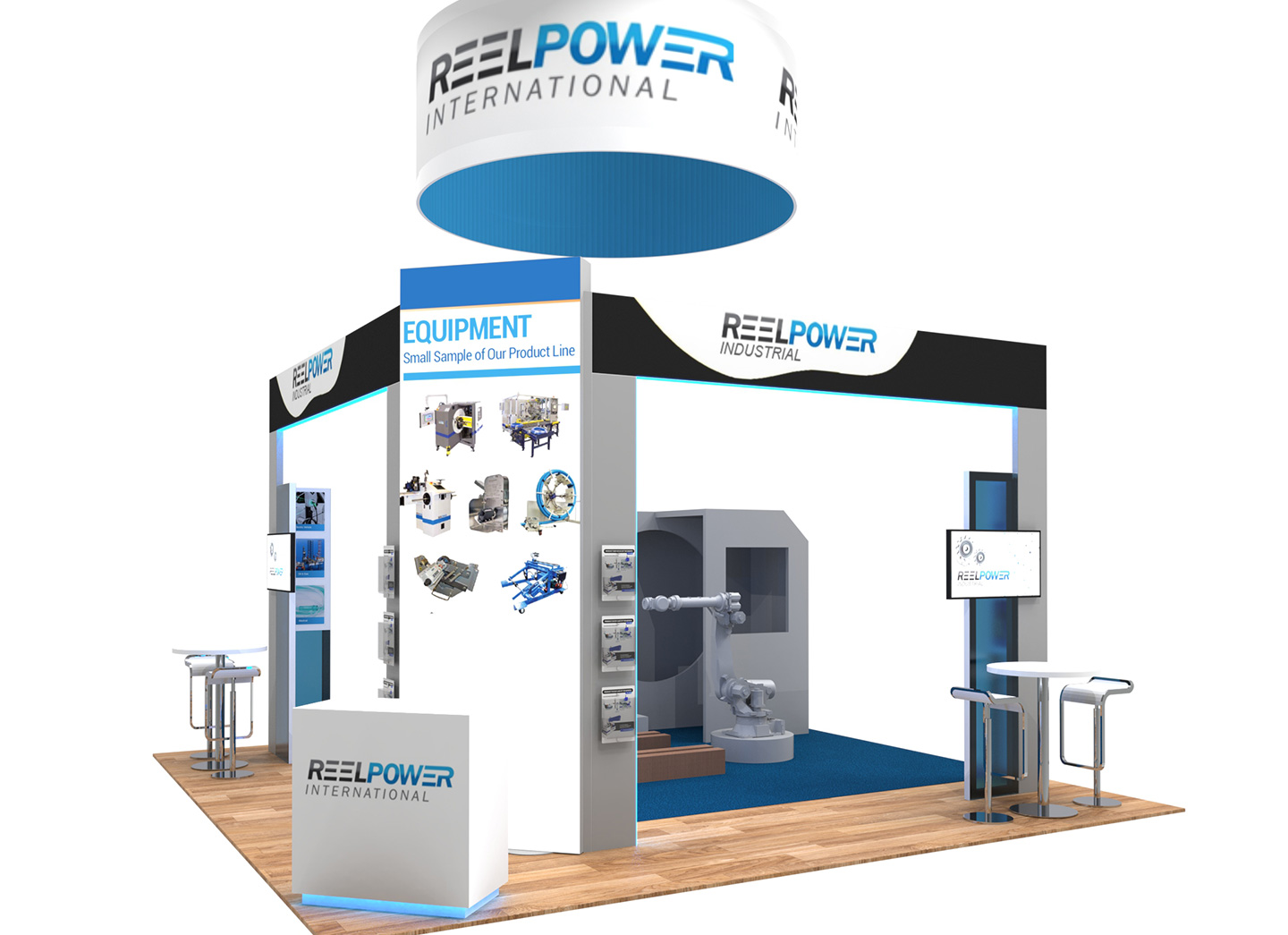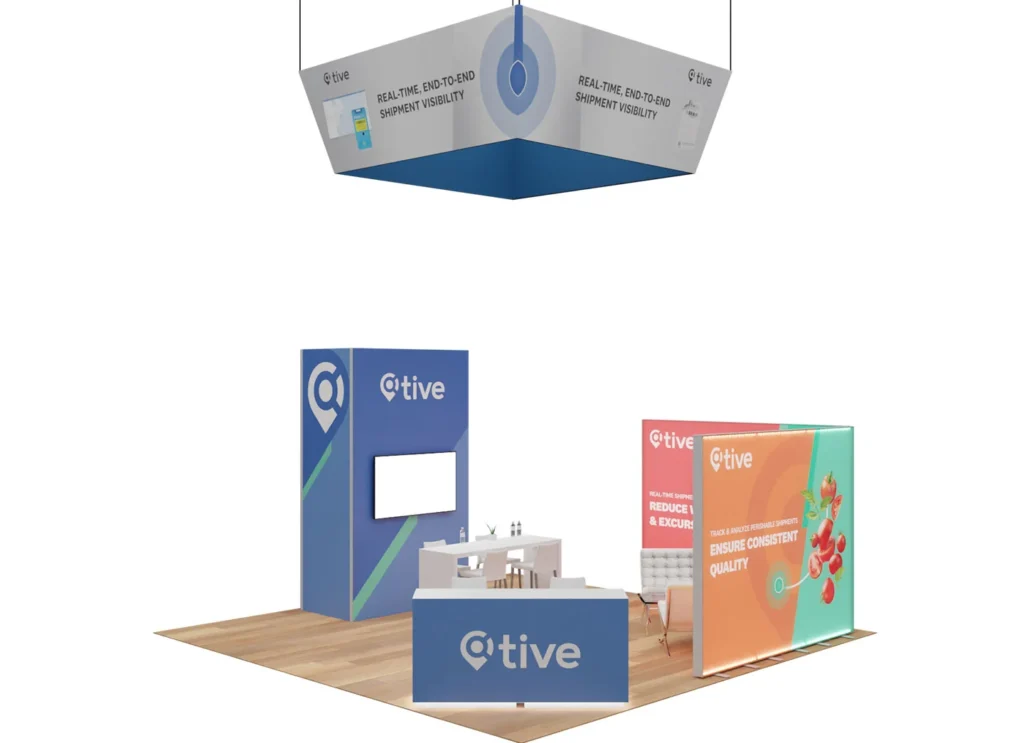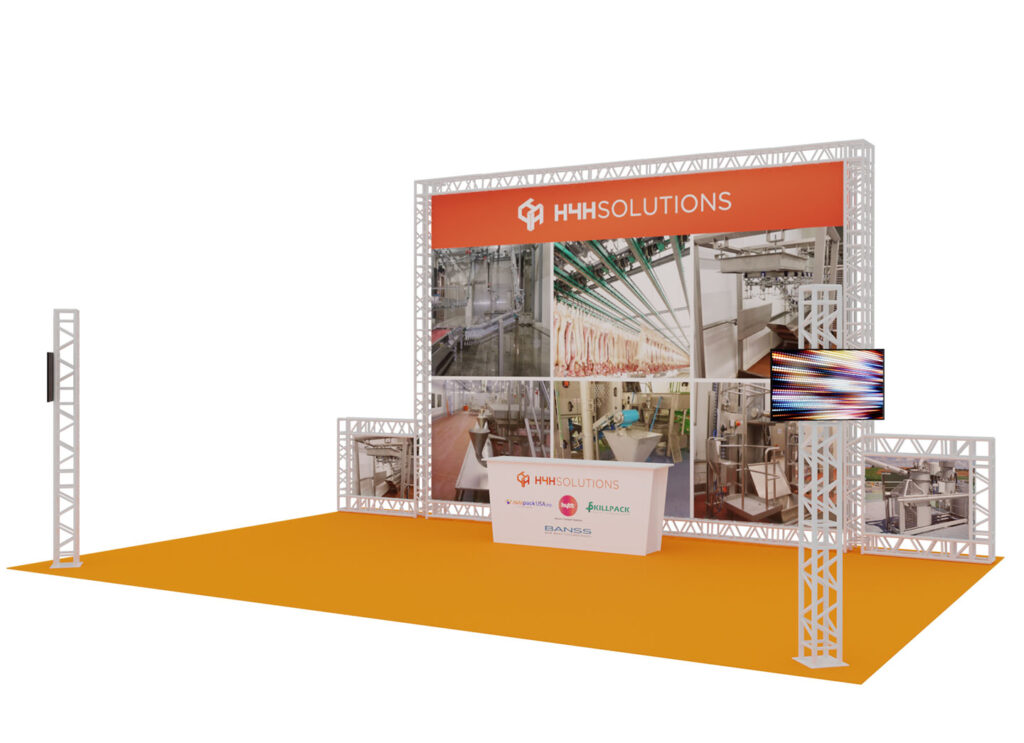TRADE SHOW BOOTHS 20×20
20 x 20 Exhibit Booth Options
Southeast Exhibits is your one-stop shop for 20×20 exhibit booth options. All of our 20×20 booths are completely customizable. You are not limited to what you see below. Use the images below for inspiration. Mix and match any elements you see, or tell us what you envision. Our designers can provide abundant suggestions, too.
( Click on any image to see a full-size image )
A 20×20 trade show booth stands as a strategic choice for exhibitors looking for an optimal blend of space and versatility. This exhibition space, measuring precisely 20 feet by 20 feet, offers a generous canvas for businesses to creatively display their products or services. It’s an arena where design meets functionality, allowing for a high degree of customization to create an immersive brand experience.
The adaptability of such a booth caters to a broad spectrum of industries, making it a popular choice for entities ranging from emerging tech ventures to established fashion labels. The essence of a 20×20 booth lies in its ability to foster engaging interactions with attendees through well-thought-out product demonstrations, interactive activities, and private discussions, all within a distinctively branded setting. Interactive displays and private meeting areas are just a couple of the features that can be integrated into this space, demonstrating its capacity to not just attract but also retain visitor interest.
Ultimately, leveraging the potential of a 20×20 booth can significantly propel a company’s visibility and engagement levels, marking it as a pivotal element in a successful trade show strategy.
Examples of Successful 20×20 Booth Designs Across Industries
To illustrate the versatility and potential of the 20×20 exhibit booth, here are examples from various industries:
- Tech Industry: A leading software company utilized a 20×20 booth with interactive touchscreens and live software demos, allowing attendees to experience their latest product offerings in real-time. The booth’s open-plan design facilitated easy access and movement, encouraging more visitor engagement.
- Fashion Industry: An emerging fashion brand showcased their new line in a 20×20 booth designed with a central runway. The perimeter featured high-definition screens displaying fashion shows, while private fitting areas allowed for exclusive previews, making a significant impact on booth visitors.
- Healthcare Industry: A healthcare equipment manufacturer designed their 20×20 booth with product demonstration zones and private consultation areas. The use of 3D models and interactive displays helped in explaining complex products, enhancing attendee understanding and engagement.
- Food and Beverage Industry: A gourmet food company used their 20×20 space to create a mini tasting room, offering samples of their products. The booth included interactive cooking demos and a seating area for discussions, making it a popular destination at the trade show.
- Automotive Industry: An automotive parts supplier featured a 20×20 booth with a central display car equipped with their latest products. Interactive kiosks provided detailed information on parts and services, attracting a targeted audience of industry professionals.
Importance in Marketing
This booth size is adept at striking a balance, providing sufficient space to display a diverse product range while fostering intimate interactions, which are crucial for building connections with potential clients.
High Visibility
The 20×20 size booth shines in its capacity for high visibility. Designed to capture attention in the bustling trade show environment, its visibility extends beyond mere size. It encompasses strategic design and branding that make the booth a magnet for attendees, drawing them in from across the exhibition hall.
Impact of High Visibility on Booth Traffic and Lead Generation
Studies and case studies have shown that booths with strategic placement and eye-catching design can see up to a 50% increase in foot traffic compared to less visible counterparts. For instance, a tech company reported a 40% increase in lead generation after investing in a 20×20 booth positioned near the entrance of a major trade show, coupled with dynamic digital displays and branded signage that stood out from the competition.
Ample Demo Space
Another key feature of the 20×20 is its ample demonstration space. This generous area allows exhibitors to showcase their products or services in an engaging, interactive way. It’s the perfect stage for live demos, interactive tech displays, or one-on-one consultations, all within the booth’s footprint.
Creative Uses of Demo Space in a 20×20 Booth
- Interactive Product Demonstrations: A home appliances brand utilized the demo space to set up live cooking shows using their latest kitchen gadgets, allowing attendees to taste the results. This hands-on approach led to a significant increase in on-site sales and post-show inquiries.
- Virtual Reality Experiences: An adventure travel company offered VR experiences within their 20×20 booth, where attendees could virtually explore exotic destinations. This immersive use of the demo space resulted in a record number of bookings during the trade show.
- One-on-One Consultations: A financial services firm set up private consultation areas within their booth, offering personalized advice sessions. This effective use of space led to a high conversion rate of consultations to new client accounts.
Designing Your Booth
When embarking on the journey of designing your 20×20 trade show exhibit, it’s imperative to focus on creating a space that embodies your brand’s essence and communicates its message effectively. Consistent branding is the cornerstone of this process, ensuring that every element, from the color palette to the graphics and messaging, cohesively narrates your brand’s story. This consistency is vital for forging a strong, memorable brand presence that attendees will recall long after the event.
An efficient layout plays a critical role in maximizing the impact of your booth. It’s designed to guide visitors seamlessly through your space, promoting engagement with your displays and facilitating interactions. Strategic placement of key areas, such as demo stations, information counters, and private meeting spaces, is crucial for fostering an environment conducive to conversation and connection.
Incorporating engaging displays is another fundamental aspect of booth design. Whether it’s through cutting-edge interactive technology, live product demonstrations, or visually striking product showcases, the goal is to captivate and intrigue your audience. These elements work together to transform your booth into an immersive experience that stands out in the bustling trade show environment, making it a must-visit destination for attendees.
Consistent Branding
Consistent branding across your 20×20 tradeshow booth is paramount for establishing a strong, cohesive brand identity. This encompasses everything from the color schemes and logos to the overall messaging and themes that resonate with your brand’s ethos. Such consistency not only aids in creating an instantly recognizable presence but also fosters trust and recognition among attendees.
Case Studies of Effective Branding
- Tech Company A utilized a vibrant color scheme consistent with their logo and product packaging, creating a visually cohesive space that attracted a high volume of visitors.
- Fashion Brand B integrated their signature patterns into the booth’s design elements, from the flooring to the display backdrops, offering an immersive brand experience.
Efficient Layout
An efficient layout is essential for the seamless operation and visitor navigation of your booth. Strategic planning ensures that each section of the booth is accessible and that the flow of traffic is intuitive, guiding visitors naturally through your space. Key considerations include clear and direct signage, optimally placed demonstration areas, and open pathways that prevent congestion.
Example Layouts
- Open Plan: Maximizes space and visibility, encouraging free movement and interaction.
- Zoned Layout: Designates specific areas for product demos, meetings, and lounging, optimizing visitor flow and engagement.
Engaging Displays
Engaging displays are the heart of a memorable 20×20 tradeshow exhibit, designed to capture and hold the attention of passersby. These can vary from cutting-edge interactive technologies and multimedia presentations to dynamic live demonstrations and tactile product interactions. The aim is to craft an environment that not only showcases your offerings but does so in a way that is immersive and storytelling.
Innovative Display Technologies
- Interactive Touchscreens: Allow visitors to explore products and services at their own pace, providing a personalized experience.
- Augmented Reality (AR): Offers an immersive experience, such as virtual product trials or interactive 3D models, enhancing product understanding and engagement.
- Dynamic LED Lighting: Uses programmable LED lights to create eye-catching displays and highlight key products or areas within the booth.
By thoughtfully integrating consistent branding, an efficient layout, and engaging displays, your booth can become a powerful tool in your marketing arsenal, creating memorable experiences that resonate with attendees and drive brand engagement.
Planning Essentials
The foundation of a successful 20×20 booth lies in thorough and strategic planning. Central to this planning phase is the establishment of clear objectives. These objectives should be directly aligned with your company’s broader marketing goals, whether they’re focused on enhancing brand visibility, generating leads, introducing new products, or directly engaging with potential and existing customers.
A clear set of goals not only informs the design and operational aspects of your booth but also serves as a benchmark for measuring the success of your participation in the trade show. Equally important is crafting a detailed budget. This comprehensive financial plan covers every element of the booth, from design and construction costs to expenses related to technology, staffing, and promotional activities.
An accurately prepared budget is crucial for the efficient allocation of resources, ensuring that every dollar spent contributes to achieving your trade show objectives. It also provides a framework for financial control, helping to avoid unexpected expenditures that could impact the overall success of the event. Selecting an experienced team is the final pillar in the planning process.
This team should encompass professionals with a range of expertise, including design, technology, sales, and customer engagement. The collective experience and skills of your team are instrumental in bringing the booth concept to life, creating an engaging visitor experience, and effectively communicating your brand’s message. Their ability to work cohesively and respond dynamically to the trade show environment can significantly influence the outcome of your trade show participation, turning booth visitors into long-term customers and brand advocates.
Clear Objectives
Establishing clear objectives is paramount when planning your booth. These goals, defined by specificity, measurability, achievability, relevance, and timeliness (SMART criteria), should seamlessly integrate into your overarching marketing strategy. Whether aiming to bolster brand awareness, generate a specific volume of leads, debut new products, or engage directly with a targeted audience, these objectives form the backbone of your planning process.
They ensure that every element of your booth, from its design to the interactive activities and messaging, is finely tuned to achieve these set goals.
Detailed Budget
Crafting a detailed budget is critical for the financial management of your tradeshow endeavor. This budget must cover every conceivable cost related to your booth, including but not limited to, design and construction expenses, technology integration, promotional materials, staffing needs, and any ancillary expenses. A meticulously planned budget is the key to prudent resource allocation, guaranteeing that every investment made is a step towards fulfilling your trade show objectives.
Moreover, it acts as a financial compass, steering your project clear of unnecessary expenditures and ensuring adherence to financial constraints.
Experienced Team Selection
The effectiveness of a tradeshow booth is significantly enhanced by the selection of an experienced team. This team should be a diverse group of professionals, each bringing expertise in areas such as design, technology, marketing, sales, and customer engagement. The collective skill set and experience of your team are instrumental in transforming the conceptual design of your booth into a dynamic, engaging space that effectively communicates your brand message.
A well-chosen team not only elevates the visitor experience but also maximizes the booth’s potential in generating valuable leads and fostering lasting customer relationships.
| Team Member Role | Expertise Required | Contribution to Booth Success |
| Designer | Graphic and Spatial Design | Ensures booth is visually appealing and functionally efficient |
| Technologist | AV and Interactive Technology | Integrates cutting-edge technology for engaging displays |
| Marketing Specialist | Branding and Promotion | Crafts compelling messaging and promotional strategies |
| Sales Representative | Product Knowledge and Sales Techniques | Engages directly with attendees to generate leads |
| Customer Engagement | Interpersonal Skills | Facilitates meaningful interactions and gathers feedback |
Maximizing Impact
Achieving a lasting impression with a trade show booth requires a strategic approach to maximizing impact. Central to this strategy is the incorporation of interactive activities that not only draw attendees in but also keep them engaged. These activities can range from hands-on product demonstrations to immersive virtual reality experiences, each designed to create a memorable interaction with your brand.
Technology integration plays a pivotal role in enhancing the booth experience. By utilizing tools like interactive touchscreens, augmented reality, or social media integrations, exhibitors can create a dynamic and engaging environment that stands out in the crowded trade show landscape. An effective follow-up strategy is the final piece of the puzzle.
This ensures that the connections made at the trade show are nurtured and developed, converting initial interest into long-term business relationships. By focusing on these key areas, exhibitors can transform their exhibit into a powerful platform for brand engagement, making a lasting impact on attendees and maximizing the return on their trade show investment.
Interactive Activities
Interactive activities serve as the heartbeat of an engaging exhibit booth. By inviting attendees to participate in live demonstrations, interactive quizzes, or even VR experiences, you transform them from mere spectators into active contributors to the booth’s atmosphere. This level of engagement not only enriches their experience but also forges a deeper, more memorable connection with your brand.
Examples of Unique Interactive Activities:
- Augmented Reality Product Demos: A furniture company used AR to let attendees visualize how products would look in their own homes, significantly increasing engagement.
- Interactive Quizzes with Instant Rewards: A health brand implemented touchscreen kiosks where attendees could take a quick health quiz and win instant prizes, enhancing booth traffic and interaction.
Tech Integration
In today’s digital age, tech integration is a game-changer for making your tradeshow booth stand out. Leveraging technologies such as virtual reality (VR), augmented reality (AR), or interactive touchscreens can catapult your booth into a new dimension of engagement. These tools offer attendees an unparalleled opportunity to interact with your products or services in a dynamic, immersive manner.
Examples of Tech Integration:
- Virtual Reality Experiences: An adventure travel agency offered VR headset tours of exotic destinations, leading to a record number of inquiries and bookings.
- Interactive Touchscreens: A software company used large interactive touchscreens to demonstrate their platform, allowing for hands-on interaction and immediate feedback.
Effective Follow-up
An effective follow-up strategy is the linchpin in converting trade show leads into lasting business relationships. This process begins with a prompt, personalized outreach that resonates with the individual interests and interactions of each lead. Utilizing a mix of communication channels—be it email, social media, or personal phone calls—ensures that the momentum built at the trade show continues to grow.
Strategies and Tools for Effective Follow-up:
- CRM Integration: Utilizing a CRM tool to categorize leads based on interest level and tailor follow-up messages accordingly.
- Personalized Email Campaigns: Crafting follow-up emails that reference specific interactions or interests shown at the booth, using email marketing software for automation and tracking.
By implementing interactive activities, integrating cutting-edge technology, and executing a thoughtful follow-up strategy, exhibitors can significantly enhance the impact of their booth, turning fleeting interactions into lasting connections and maximizing the overall return on their trade show investment.
Common Mistakes
When it comes to setting up a 20×20 exhibit booth, there are several pitfalls that exhibitors often encounter. A prevalent issue is the tendency towards a cluttered design. This mistake comes from the desire to showcase as much as possible within the limited space, leading to a booth that feels cramped and chaotic.
Such an environment can overwhelm visitors, making it hard for them to absorb your brand’s key messages or even dissuade them from entering your booth altogether. Another critical oversight involves poor lighting and AV setup. Effective lighting is essential for creating an inviting atmosphere and highlighting your booth’s main attractions.
Similarly, high-quality audio-visual components are crucial for engaging presentations and demonstrations. Neglecting these aspects can result in a booth that fails to capture the attention of passersby or properly convey your brand’s message. Addressing these common mistakes early in the planning process can greatly improve the visitor experience and the overall success of your tradeshow participation.
Cluttered Design
A cluttered design is a common pitfall that can undermine the impact of a tradeshow booth. This issue often arises from the urge to display as much as possible within the confines of the booth, leading to a space that feels overcrowded and chaotic. Such clutter not only detracts from the booth’s aesthetic appeal but also makes it difficult for visitors to focus on the key messages and products you wish to highlight.
The antidote to clutter is strategic simplicity; by carefully selecting and showcasing only the most essential elements, you can create a more inviting and effective exhibit space.
Visual Transformation Examples:
- Before and After Images: Showcasing a booth before decluttering, with visuals crammed into every available space, versus after simplification, where each element has room to breathe and stand out, can dramatically illustrate the benefits of a clean design approach.
Poor Lighting and AV
Poor lighting and AV setup is another critical mistake that can diminish the effectiveness of your tradeshow booth. Proper lighting is essential for creating an inviting ambiance and ensuring that your displays and products are seen in the best light. Meanwhile, reliable audio-visual equipment is crucial for engaging presentations and interactive experiences.
Neglecting these aspects can result in a booth that fails to capture attention or communicate effectively with the audience. Investing in quality lighting and AV solutions is an investment in the overall success of your tradeshow presence, enhancing both the visibility and appeal of your booth.
Common Mistakes and Tips:
- Inadequate Lighting: Using dim or uneven lighting that creates shadows or dark spots can make displays hard to see and reduce the overall appeal of the booth.
- Poor Sound Quality: Relying on built-in microphone and speaker systems that can’t adequately project in a noisy environment leads to lost engagement.
Tips for High-Quality Setups:
- Lighting: Invest in professional-grade LED lights that provide bright, even lighting across your booth without creating harsh shadows.
- Audio-Visual: Use external speakers and microphones designed for trade show environments to ensure clear sound quality. Consider hiring an AV professional to manage setup and troubleshooting during the event.
By avoiding these common mistakes and implementing strategic design and technical solutions, exhibitors can significantly enhance the appeal and effectiveness of their booth, creating a welcoming and engaging environment for all attendees.
Booth Construction and Setup
Constructing and setting up a 20×20 display booth involves critical steps that determine the overall success and impact of your exhibit. Selecting durable materials is paramount, ensuring that your booth not only presents a polished and professional image but also withstands the demands of frequent assembly, disassembly, and transportation. This durability is essential for maintaining a high-quality appearance throughout the event and across future shows.
Professional assembly is equally crucial, necessitating experienced personnel capable of erecting the booth efficiently while adhering to all safety standards. This expertise not only guarantees that the booth is visually appealing but also ensures it is structurally secure, offering a safe environment for both your team and your visitors. Incorporating safety considerations into every stage of the booth construction and setup process is indispensable.
Compliance with venue regulations, use of non-hazardous materials, and a design that prevents overcrowding and facilitates easy emergency evacuation are all essential. By focusing on these aspects, you ensure that your display booth is not just an effective marketing tool but also a safe and inviting space for engaging with attendees.
Durable Materials
Selecting durable materials for your display is a critical decision that impacts both the booth’s aesthetic appeal and its resilience. High-quality, robust materials ensure that the booth can endure the physical demands of transportation, setup, and dismantling, maintaining its integrity and professional appearance over time. This durability is key to presenting a consistently impressive and inviting space to attendees, safeguarding your investment and brand image across numerous events.
Professional Assembly
Professional assembly is indispensable for erecting a tradeshow booth that is both visually striking and functionally sound. Expert assembly teams bring precision and efficiency to the construction process, ensuring every element of the booth is securely and correctly installed. This expertise not only enhances the booth’s overall presentation but also its safety and reliability, providing a smooth and engaging experience for visitors and staff alike.
Safety Considerations
Safety considerations are important in the design and setup of your booth. Adhering to all relevant safety regulations and standards is essential for creating a secure environment. This includes using non-hazardous materials, ensuring structural stability, and designing a layout that prevents overcrowding and allows for quick and easy evacuation if necessary.
By prioritizing safety, you not only protect the well-being of your team and attendees but also foster a positive and welcoming atmosphere at your booth.

